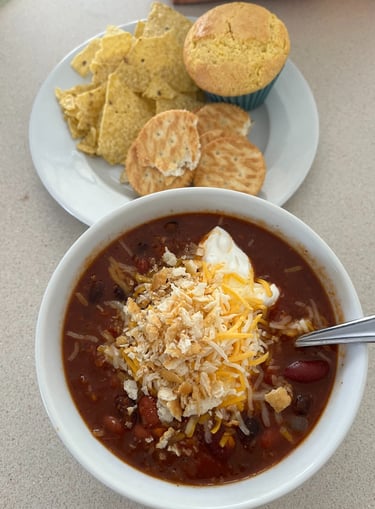the best spaces aren’t perfect—they’re simply planty
Simply Living: Grocery Budgeting Tips (Under $250/month for a 2-Person Household)
Discover practical grocery budgeting tips for couples! Learn how we keep our monthly grocery bill under $250 for a 2-person household with simple, plant-forward meals, smart shopping hacks, and sustainable living strategies.
9/21/20254 min read
Introduction
At Simply Planty, we believe that living well doesn’t have to mean spending more. Grocery shopping is one of the biggest household expenses, but with a little planning and creativity, it’s possible to eat healthy, balanced, plant-forward meals without breaking the bank. In this post, I’m sharing exactly how my husband and I keep our grocery budget under $250 a month for our 2-person household. If you’re ready to save money, reduce waste, and still enjoy meals you love, no matter your household size, these tips are for you.
1. Set a Realistic Budget and Track It
The first step is deciding on a monthly grocery spending goal or cap. For us, that’s $250 for two adults. We track every trip (not just for groceries but for all other expenses) using a simple budget tracker. You can create one for free in Google Sheets with grouped expense categories for easy collapse/expand. Keeping a running total helps us stay accountable.
2. Build Your Meals Around Affordable Staples
Our grocery list focuses on versatile, fiber-forward, high-protein staples:
Bulk items: rice, oats, flour, sugar, seeds (chia, quinoa)
Dry goods: pasta, nuts, lentils
Frozen produce: spinach, broccoli, berries
Shelf-stable basics: canned tomatoes, black beans, chickpeas, peanut butter
These stretch far, reduce food waste, and form the base of countless recipes.
3. Shop Smart (and Seasonal)
Buy in bulk where it makes sense (like dry beans instead of canned).
Choose seasonal produce—cheaper, fresher, and more flavorful.
Use store brands, and not just for basics like flour, oats, or spices, but anywhere the quality competes.
Shop discount or ethnic markets, which often have better prices on produce and pantry items.
4. Cook at Home (and Keep It Simple)
We rarely eat out and never pay for delivery—home cooking keeps costs low and health high. Simple plant-forward meals save time and money. Some of our budget-friendly staples include:
Breakfast:
Oats with fruit and seeds for breakfast - Oats are so versatile. Make them savory or sweet. Prep them overnight or microwave for 1 min for a quick meal. Add yogurt, peanut butter, and any topping you'd like.
This is one of they key swaps we've made to make our daily go-to breakfast healthier and more forward compared to cereals or expensive ready-made meals.
Lunch:
Keep it simple - eat leftovers as a default to mitigate food waste.
Otherwise - sandwiches, easy grab-and-go fruits and veggies like carrots, bananas, apples, or oranges
Dinner:
Pasta with roasted veggies - we love Rao's pasta sauce but consider it a splurge items at $8 a bottle. We found a dupe recipe online and now make our own sauce when we can!
Bean burritos - black bean or refried beans with whatever extras you like (salsa, sour cream, cheese)
Fajitas - a fancier version of the burrito adding sautéed peppers and onions to the mix
Breakfast for dinner - pancakes, waffles, eggs and biscuits
Soups and chilli - great multi-day bulk meals
Veggie stir-fries over rice
Salads of any variety
Pro tip: make your own bread at home. Whether you have a sourdough starter or active/instant dry yeast, homemade bread is an easy and very cost-effective addition to any meal.
What to avoid: any ready-made meals (think frozen, microwavable options) and single-serve package goods (individual yogurts, snack packs). While these can be very convenient on a busy night, or helpful grab-and-go resources before you hop in the car for an unexpected/extended outing, try to limit them to these use cases. On the daily, these drive up costs fast.
Do instead: Meal-prep where possible and buy items in bulk (yogurt by the tub, snacks by the big bag) and portion out into reusable containers like by Pyrex and Stasher.
5. Reduce Food Waste
Plan meals around what you already have.
Store produce properly (greens wrapped in a damp cloth, carrots in water, etc.).
Freeze extras (soups, rice, bananas for smoothies).
Less waste = more savings.
6. Use Tools & Products That Help
These small investments make grocery budgeting easier:
Reusable produce bags → cut down on plastic & food waste.
Glass storage containers → keep leftovers fresh.
Bulk jars → for pantry staples like beans, rice, and flour.
👉 Explore more sustainable swaps in Simply Home.
7. Treat Yourself (Mindfully)
We always leave a little room for small treats—coffee beans, chocolate, or fresh bread from a local bakery. The key is moderation—indulgence can still fit into your budget!
Closing Thoughts
Keeping a 2-person grocery budget under $250 a month is possible with the right mix of planning, smart shopping, and simple meals. By focusing on staples, reducing waste, and making mindful choices, you’ll find that living simply is both affordable and deeply rewarding.
If you loved these tips, check out more resources here:










As an Amazon Associate I earn from qualifying purchases
Essentials
Curate a balanced, cozy, and joyful life.
Sustainability
Joyful
© 2025. All rights reserved.